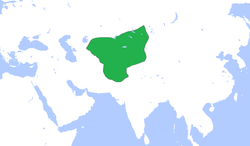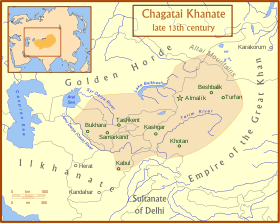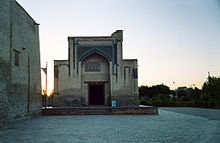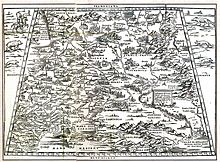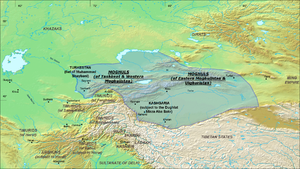- Chagatai Khanate
-
Chagatai Khanate
Цагадайн хаант улс улс
Tsagadai Khaantu Ulus← 
1225–1687  →
→
 →
→
 →
→Flag of Chagatai Khanate
The Chagatai Khanate (green), c. 1300. Capital Almalik, Qarshi Language(s) Middle Mongolian, Turkic Religion Tengerism, Buddhism, Christianity later Islam Government Semi-elective monarchy, later hereditary monarchy Khan - 1225–1242 Chagatai Khan - 1388–1402 Sultan Mahmud - 1681–1687 Muhammad Imin Khan Legislature Kurultai Historical era Late Middle Ages - Chagatai Khan inherited part of Mongol Empire 1225 - Chagatai Khanate became virtually independent after the death of Mongke Khan 1260 - Made peace with Temur Khan of the Yuan Dynasty and other khanates of the Mongol Empire and acknowledged the Great khans' supremacy 1304 - Transoxiana captured by Tamerlane 1370 - Remaining domains fell to Apaq Khoja and Ak Tagh with help from Dzungars 1687 Area - 1310 est. 1,000,000 km2 (386,102 sq mi) - 1350 est.[1] 3,500,000 km2 (1,351,358 sq mi) Currency Coins (dirhams and Kebek coins) The Chagatai Khanate (Cyrillic: Цагаадайн улс) was a Turko-Mongol[2] khanate that comprised the lands ruled by Chagatai Khan (alternative spellings Chagata, Chugta, Chagta, Djagatai, Jagatai, Chaghtai), second son of the Great Khan Genghis Khan, and his descendents and successors. Initially it was considered a part of the Mongol Empire, but it later became fully independent.
At its height in the late 13th century, the Khanate extended from the Amu Darya south of the Aral Sea to the Altai Mountains in the border of modern-day Mongolia and China.[3]
The khanate lasted in one form or another from 1220s until the late 17th century, although the western half of the khanate was lost to Tamerlane in the 1360s. The eastern half remained under Chagatai khans who were, at times, allied or at war with Timur's successors. Finally, in the 17th century, the remaining Chagatai domains fell under the theocratic regime of Apaq Khoja and his descendants, the Khojijans, who ruled East Turkestan under Dzungar and Manchu overlordships consecutively.
Contents
Formation
Genghis Khan's empire was inherited by his third son, Ögedei, the designated Great Khan who personally controlled the lands east of Lake Balkash as far as Mongolia. Tolui, the youngest, the keeper of the hearth, was accorded the northern Mongolian homeland. Chagatai, the second son, received Transoxania, between the Amu Darya and Syr Darya rivers in modern Uzbekistan, and the area around Kashgar. He made his capital at Almalik near what is now Kulja in northwestern China.[4] Apart from problems of lineage and inheritance, the Mongol Empire was endangered by the great cultural and ethnic divide between the Mongols themselves and their mostly Islamic Turkic subjects.
When Ögedei died before achieving his dream of conquering all of China, there was an unsettled transition to his son Güyük (1241) overseen by Ögedei's wife Töregene who had assumed the regency for the five years following Ögedei's death. The transition had to be ratified in a kurultai, which was duly celebrated, but without the presence of Batu, the independent-minded khan of the Golden Horde.[5] After Güyük's death, Batu sent Berke, who maneuvered with Tolui's widow, and, in the next kurultai (1253), the Ögedite line was passed over for Möngke, Tolui's son, who was said to be favorable to Nestorian Christianity.[6] The Ögedite ulus was dismembered; only the Ögedites who not immediately go into opposition were given minor fiefs.[7]
The Chagatai Khanate after Chagatai
History of the Mongols 
Before Genghis Khan Khamag Mongol Mongol Empire Khanates - Chagatai Khanate - Golden Horde - Ilkhanate - Yuan Dynasty Northern Yuan Timurid Empire Mughal Empire Crimean Khanate Khanate of Sibir Zunghar Khanate Mongolia during Qing Outer Mongolia (1911-1919) Republic of China (Occupation of Mongolia) Mongolian People's Republic (Outer Mongolia) Modern Mongolia Mengjiang (Inner Mongolia) People's Republic of China (Inner Mongolia) Republic of Buryatia Kalmyk Republic Hazara Mongols Aimak Mongols Timeline edit box Chagatai died in 1242, shortly after his brother Ögedei. For nearly twenty years after this the Chagatai Khanate was little more than a dependency of the Mongol central government, which deposed and appointed khans as it pleased. The cities of Transoxiana, while located within the boundaries of the khanate, were administrated by officials who answered directly to the Great Khan.[8]
This state of subservience to the central government was ended during the reign of Chagatai's grandson Alghu (1260–1266), who took advantage of the civil war between Khubilai and Ariq Boke by revolting against the latter, seizing new territories and gaining the allegiance of the Great Khan's authorities in Transoxiana.[9] Most of the Chagatayids first supported Khubilai but in 1269 they joined forces with the House of Ogedei.[10]
Alghu's eventual successor, Baraq (1266–1271), who expelled the Khubilai Khan's governor in Chinese Turkestan, soon came into conflict with the Ögedite Kaidu (Qaidu), who gained the support of the Golden Horde and attacked the Chagatayids.[11]
Baraq was soon confined to Transoxiana and forced to become a vassal of Kaidu.[12] At the same time, he was at odds with Abaqa, the Ilkhan, who ruled his Ilkhanate in Persia. Baraq attacked first, but was defeated by the Ilkhanate army and forced to return to Transoxiana, where he died not long after.[13]
The next several Chagatayid khans were appointed by Kaidu,[14] who maintained a hold upon the khanate until his death. He finally found a suitable khan in Baraq's son Duwa (1282–1307), who participated in Kaidu's wars with Khubilai khan and his successors of the Yuan Dynasty.[15] The two rulers also were active against the Ilkhanate.[16] After Kaidu's death in 1301, Duwa threw off his allegiance to his successor. He also made peace with the Yuan Dynasty and paid tributes to the Yuan court; by the time of his death the Chagatai Khanate was a virtually independent state.[17]
End of Chagatayid rule in Transoxiana
Duwa left behind numerous sons, many of whom became khans themselves. Included among these are Kebek (1309, 1318–1326), who instituted a standardization of the coinage and selected a sedentary capital (at Qarshi), and Tarmashirin (1326–1334), who converted to Islam and raided the Sultanate of Delhi in India. The center of the khanate was shifting to the western regions, i.e. Transoxiana. Tarmashirin, however, was brought down by a rebellion of the tribes in the eastern provinces and the khanate became increasingly unstable in the following years. In 1346 a tribal chief, Qazaghan, killed the Chagatai khan Qazan during a revolt.[18]
Qazan's death marked the end of effective Chagatayid rule over Transoxiana. Administration of the region fell into the hands of the local tribes (which were mostly Turkic or Turko-Mongol) who were loosely allied with one another. In order to legitimatize their rule, they maintained a member of the house of Genghis Khan on the throne, but these khans were no more than puppets.[19] Using the disintegration, Janibeg Khan of the Golden Horde asserted Jochid dominance over the Chagatai Khanate, attempting to unite 3 khanates of the Mongol Empire. But the Jochids lost Azerbaijan to the Jalayirids and the Chagataids expelled his administrators after his death in 1357.[20]
The only serious attempt to restore Chagatayid rule in Transoxiana came from Tughlugh Timur (who will be discussed below), who invaded Transoxiana twice and attempted to neutralize the power of the tribes. He was unsuccessful, however, and died soon afterwards. When his army departed the region, control of Transoxiana was contested by two tribal leaders, Amir Husayn (the grandson of Qazaghan) and Timur or Tamerlane. Timur eventually defeated Amir Husayn and took control of Transoxiana (1369–1405).
Like his predecessors, Timur maintained a puppet khan on the throne to legitimatize his rule, but his khans were members of the house of Ögedei, not descendants of Chagatai.[21] For over three decades, Timur used the Chagatai lands as the base for extensive conquests, conquering Herat in Afghanistan, Shiraz in Persia, Baghdad in Iraq, and Damascus in Syria. After defeating the Ottoman Turks at Angora, Timur died in 1405 while marching on China. After his death his successors, the Timurids, are also reported to have had their own shadow khans until the mid-15th century. Nevertheless, the Chagatai legacy lived on; Timur's troops were called Chagatais,[22] and the literary language used the Timurids and their Moghul neighbors to the east was called Chagatai Turkic.[23]
Chagatayid rule continued in East Turkestan
Beginning in the mid-14th century a new khanate, in the form of a nomadic tribal confederacy headed by a member of the family of Chagatai, arose in the region of the Ili River. It is therefore considered to be a continuation of the Chagatai Khanate, but it is also referred to as the Moghul Khanate,[24] since its tribal inhabitants were originally considered to be pure "Moghuls" (i.e., Mongols), in contrast to the mostly Turkic and Turkicised Mongols of Transoxiana.[25]
The eastern regions of the Chagatai Khanate in the early 14th century had been inhabited by a number of Mongol nomadic tribes. These tribes resented the conversion of Tarmashirin to Islam and the move of the khan to the sedentary areas of Transoxiana. They were behind the revolt that ended in Tarmashirin's death. One of the khans that followed Tarmashirin, Changshi, favored the east and was anti-Muslim.[26]
In the 1340s as a series of ephemeral khans struggled to hold power in Transoxiana, little attention was paid by the Chagatayids to the eastern regions. As a result, the eastern tribes there were virtually independent. The most powerful of the tribes, the Dughlats, controlled extensive territories in Moghulistan and the western Tarim Basin. In 1347 the Dughlats decided to appoint a khan of their own, and raised the Chagatayid Tughlugh Timur to the throne.[27]
Tughlugh Timur (1347–1363) was thereby made the head of a tribal confederacy that governed the Tarim Basin and the steppe area of Moghulistan (named after the Moghuls). His reign was contemporaneous with the series of puppet khans that ruled in Transoxiana, meaning that there were now effectively two khanates headed by Chagatayids: one in the west, centered in Transoxiana, and one in the east, centered in Moghulistan. Unlike the khans in the west, however, Tughlugh Timur was a strong ruler who converted to Islam (1354) and sought to reduce the power of the Dughlats.[28] In 1360 he took advantage of a breakdown of order in Transoxiana and his legitimacy as descendant of Chagatai Khan[29] to invade the region and take control of it, thereby temporarily reuniting the two khanates. Despite invading a second time in 1361 and appointing his son Ilyas Khoja as governor of Transoxiana, however, Tughlugh Timur was unable to keep a lasting hold on the region, and the Moghuls were ultimately expelled by Amir Husayn and Timur, who then fought amongst themselves for control of Transoxiana.[30]
Chagatayid rule in Moghulistan was temporarily interrupted by the coup of the Dughlat amir Qamar ud-Din, who likely killed Ilyas Khoja and several other Chagatayids. The Moghuls that remained obedient to him were constantly at war with Timur, who invaded Moghulistan several times but was unable to force its inhabitants into submission.[31] A Chagatayid restoration occurred in the 1380s, but the Dughlats retained an important position within the khanate; for the next forty years they installed several khans of their own choosing.[32]
This cycle was broken by Uvais Khan (1418–1428), a devout Muslim who was frequently at war with the Oirats (Western Mongols) who roamed in the area east of Lake Balkash. He was usually defeated and even captured twice by the Oirat Esen Tayishi, but was able to secure his release both times. Uvais Khan was followed by Esen Buqa (1428–1462), who frequently raided the Timurid Empire to the west. Late in his reign he was contested by his brother Yunus Khan (1462–1487), who had raised to the khanship by the Timurids in an attempt to counter Esen Buqa. Yunus Khan defeated the Uzbeks and maintained good relations with the Kazakhs and Timurids, but the western Tarim Basin was lost to a revolt by the Dughlats. In 1484 he captured Tashkent from the Timurids.[33]
During the fifteenth century the Moghul khans became increasingly Turkified. Yunus Khan is even mentioned to have the looks of a Tajik instead of those of a Mongol.[34] This Turkification may not have been as extensive amongst the general Moghul population,[35] who were also slower to convert to Islam than the khan and top amirs (although by the mid-fifteenth century the Moghuls were considered to be largely Muslim[36]). The khans also adopted the Islamic sharia in favor of the Mongol yasa.[37]
After Yunus Khan's death his territories were divided by his sons. Ahmad Khan (1487–1503), who took eastern Moghulistan and Uighuristan, fought a series of successful wars against the Oirats, raided Chinese territory and attempted to seize the western Tarim Basin from the Dughlats, although he was ultimately unsuccessful. In 1503 he traveled west to assist his brother Mahmud Khan (1487–1508), the ruler of Tashkent and western Moghulistan, against the Uzbeks under Muhammad Shaybani. The brothers were defeated and captured; they were released but Tashkent was seized by the Uzbeks. Ahmad Khan died soon after and was succeeded by his son Mansur Khan (1503–1545), who captured Hami, a Chinese dependency, in 1513. Mahmud Khan spent several years trying to regain his authority in Moghulistan; he eventually gave up and submitted to Muhammad Shaybani, who executed him.[38]
Mansur Khan's brother Sultan Said Khan (1514–1533) conquered the western Tarim Basin from the Dughlats in 1514 and set himself up in Kashgar. Thereafter the Moghul Khanate was permanently divided, although Sultan Said Khan was nominally a vassal of Mansur Khan in Turpan. After Sultan Said Khan's death he was succeeded by Abdurashid Khan (1533–1565), who began his reign by executing a member of the Dughlat family. A nephew of the dead amir, Mirza Muhammad Haidar Dughlat fled to Mughal Empire in India and eventually conquered Kashmir, where he wrote a history of the Moghuls. Abdurrashid Khan also fought for control of Moghulistan against the Kirghiz and the Kazakhs, but Moghulistan was ultimately lost; thereafter the Moghuls were largely restricted to possession of the Tarim Basin.[39]
End of Chagatayid rule
In the late sixteenth and early seventeenth centuries, the Moghul khanate of Kashgar underwent a period of decentralization, with numerous subkhanates springing up with centers at Kashgar, Yarkand, Aksu and Khotan. At the same time, the khans increasingly gave up secular power to the khojas, until they were the effectively the governing power in Kashgaria. The khojas themselves were divided into two sects: the Aq Taghlik and the Kara Taghlik. This situation persisted until the 1670s, when the Moghul khans apparently tried to reassert their authority by expelling the leader of the Aq Taghlik.[40] The Aq Taghlik responded by requesting the assistance of the Dzungars (who were Oirats); the Dzungars invaded Kashgaria, imprisoned the khan, and installed the Aq Taghlik in Kashgar. They also helped the Aq Taghlik overcome the Kara Taghlik in Yarkand. A short time later, the Moghul kingdom of Turpan and Hami was also conquered by the Dzungars.[41] The Tarim Basin fell under the overall rule of the Dzungars until it was taken by the Manchu Emperors of China in the mid-18th century.[42]
Notes
- ^ Turchin, Peter; Adams, Jonathan M.; Hall, Thomas D (December 2006). "East-West Orientation of Historical Empires". Journal of world-systems research 12 (2): 219–229. ISSN 1076–156x. http://jwsr.ucr.edu/archive/vol12/number2/pdf/jwsr-v12n2-tah.pdf. Retrieved 12 August 2010.
- ^ Xinjiang: China's Muslim Borderland, S. Frederick Starr, pg. 243
- ^ See Barnes, Parekh and Hudson, p. 87; Barraclough, p. 127; Historical Maps on File, p. 2.27; and LACMA for differing versions of the boundaries of the khanate.
- ^ Grousset, pp. 253–4
- ^ Grousset, pp. 268–9
- ^ Grousset, pp. 272–5
- ^ For example Kaidu, who received Qayaliq, in modern Kazakhstan. Biran, pp. 19–20. He later revolted against Khubilai Khan and forcefully made the Chagatai khans his vassals for three decades, as will be discussed below.
- ^ Grousset, pp. 328–9
- ^ Biran, pp. 21–2
- ^ Thomas T. Allsen-Culture and Conquest in Mongol Eurasia, p.24
- ^ Biran, p. 25
- ^ Biran, pp. 25–6
- ^ Biran, pp. 30–2
- ^ Biran, p. 33
- ^ Biran, pp. 50–2
- ^ Biran, pp. 59–60
- ^ Biran, pp. 71–6
- ^ Grousset, pp. 341–2
- ^ Manz, pp. 43–4. For more details about this time period, see the articles Qazaghan, Abdullah ibn Qazaghan, and Buyan Suldus, the individuals who held the position of ulus beg, or amir of the ulus, and who were the most powerful tribal leaders within Transoxiana
- ^ Christopher P.Atwood - Encyclopedia of the Mongol Empire and Mongolia, see: Chagatay Khanate
- ^ First Suurgatmish (1370-1388), then Sultan Mahmud (1388-1402). Grousset, p. 416
- ^ Barthold, "Caghatai-Khan", p. 814
- ^ Chagatai Turkic is now an extinct literary language, but it was relatively common in Central Asia up until Soviet times. Karpat, p. 10. Both the modern Uzbek and the Uyghur languages are closely related to it.
- ^ Kim, p. 290; n.1 discusses the various names used for this khanate. In addition, Timurid authors pejoratively called the Moghuls Jatah, or "worthless people." Elias, p. 75
- ^ Roemer, p.43
- ^ Grousset, p. 341
- ^ Grousset, pp. 343–4
- ^ Kim, pp. 302–3
- ^ After the execution of Shah Temur (1358) the Transoxianan Turkic amirs had not bothered to appoint a new puppet khan, meaning that there was not even a shadow khan in the west that could be used to oppose Tughlugh Timur's legitimist claims
- ^ Grousset, pp. 409–11. For details of the battles between Amir Husayn and Timur for control of Transoxiana, see Manz, Chapter 3
- ^ Kim, p. 306
- ^ Barthold, "Dughlat", p. 622
- ^ Grousset, pp. 491–5
- ^ Grousset, p. 495
- ^ Elias, p. 78
- ^ Muhammad Haidar Mirza, p. 58
- ^ Muhammad Haidar Mirza, pp. 69–70
- ^ Grousset, pp. 495–7
- ^ Grousset, pp. 499–500
- ^ Grousset, pp. 500–1
- ^ Grousset, pp. 527–8
- ^ Elias, pp. 125–6
References
- Barnes, Ian, Bhikhu Parekh and Robert Hudson. The History Atlas of Asia. MacMillan, p. 87. Macmillian, 1998. ISBN 0028625811
- Barraclough, Geoffrey. The Times Atlas of World History. 4th Ed. Hammond World Atlas Corporation, 1993. ISBN 0723005346
- Barthold, W. "Caghatai-Khan." The Encyclopedia of Islam, Volume 2. New Ed. Leiden: E. J. Brill, 1965.
- ---. "Dughlat." The Encyclopedia of Islam, Volume 2. New Ed. Leiden: E. J. Brill, 1965.
- Biran, Michal. Qaidu and the Rise of the Independent Mongol State in Central Asia. Richmond, Great Britain: Curzon Press, 1997. ISBN 0700706313
- "The Chagatai Khanate". The Islamic World to 1600. 1998. The Applied History Research Group, University of Calgary. Retrieved 19 May 2005.
- Elias, N. Commentary. The Tarikh-i-Rashidi (A History of the Moghuls of Central Asia). By Mirza Muhammad Haidar. Translated by Edward Denison Ross, edited by N. Elias. London, 1895.
- Grousset, René. The Empire of the Steppes: A History of Central Asia. Trans. Naomi Walford. New Jersey: Rutgers, 1970. ISBN 0813513049
- Karpat, Kemal H. "The Ottoman Rule in Europe From the Perspective of 1994." Turkey Between East and West. Ed. Vojtech Mastny and R. Craig Nation. Boulder, CO: Westview Press, 1996. ISBN 0813324203
- Kim, Hodong. "The Early History of the Moghul Nomads: The Legacy of the Chaghatai Khanate." The Mongol Empire and Its Legacy. Ed. Reuven Amitai-Preiss and David Morgan. Leiden: Brill, 1998. ISBN 9004110488
- Manz, Beatrice Forbes. The Rise and Rule of Tamberlane. Cambridge University Press: Cambridge, 1989. ISBN 0521633842
- "Map of the Mongol Empire". LACMA.org. 2003. Los Angeles County Museum of Art. Retrieved 8 July 2008.
- Mirza Muhammad Haidar. The Tarikh-i-Rashidi (A History of the Moghuls of Central Asia). Translated by Edward Denison Ross, edited by N.Elias. London, 1895.
- "Mongol Invasions of Russia, 12th-13th Centuries". Map. Historical Maps on File: Ringbound. 2nd Ed. Facts on File, 2002. ISBN 081604600X
- Roemer, H. R. "Timur in Iran." The Cambridge History of Iran, Volume 6: The Timurid and Safavid Periods. Ed. Peter Jackson and Lawrence Lockhart. London: Cambridge University Press, 1986. ISBN 0521200946
A history of empires Ancient empires Medieval empires Byzantine · Hunnic · Arab (Rashidun · Umayyad · Abbasid · Fatimid · Caliphate of Córdoba · Ayyubid) · Moroccan (Idrisid · Almoravid · Almohad · Marinid) · Persian (Tahirid · Samanid · Buyid · Sallarid · Ziyarid) · Ghaznavid · Bulgarian (First · Second) · Benin · Great Seljuq · Oyo · Bornu · Khwarezmian · Aragonese · Timurid · Indian (Chola · Gurjara-Pratihara · Pala · Eastern Ganga dynasty · Delhi) · Mongol (Yuan · Golden Horde · Chagatai Khanate · Ilkhanate) · Kanem · Serbian · Songhai · Khmer · Carolingian · Holy Roman · Angevin · Mali · Chinese (Sui · Tang · Song · Yuan) · Wagadou · Aztec · Inca · Srivijaya · Majapahit · Ethiopian (Zagwe · Solomonic) · Somali (Ajuuraan · Warsangali) · AdaliteModern empires Tongan · Indian (Maratha · Sikh · Mughal) · Chinese (Ming · Qing) · Ottoman · Persian (Safavid · Afsharid · Zand · Qajar · Pahlavi) · Moroccan (Saadi · Alaouite) · Ethiopian · Somali (Dervish · Gobroon · Hobyo) · French (First · Second) · Austrian (Austro-Hungarian) · German · Russian · Swedish · Mexican (First · Second) · Brazil · Korea · Japan · Haitian (First · Second) · Central AfricanColonial empires Turkic topics Languages Afshar · Altay · Äynu · Azerbaijani · Bashkir · Bulgar · Chagatai · Chulym · Chuvash · Crimean Tatar · Cuman · Dolgan · Fuyü Gïrgïs · Gagauz · Hunnic · Ili Turki · Karachay-Balkar · Karaim · Karakalpak · Karamanli Turkish · Kazakh · Khakas · Khalaj · Khazar · Khorasani Turkic · Kipchak · Krymchak · Kumyk · Kypchak group · Kyrgyz · Nogai · Old Turkic · Ottoman Turkish · Pecheneg · Qashqai · Sakha · Salar · Shor · Tatar · Tofa · Turkic Avar · Turkish · Turkmen · Tuvan · Urum · Uyghur · UzbekPeoples Ahiska · Altays · Avars · Azeris · Balkars · Bashkirs · Bulgars · Chulyms · Chuvashs · Crimean Tatars · Cumans · Dolgans · Gagauz · Huns · Iraqi Turkmen · Karachays · Karaites · Karakalpaks · Karapapak · Karluks · Kazakhs · Khakas · Khalajs · Khazars · Khorasani Turks · Kimek · Kipchaks · Krymchaks · Kumandins · Kumyks · Kyrgyz · Naimans · Nogais · Oghuz Turks · Qashqai · Salar · Shatuo · Syrian Turkmens · Tatars · Telengit · Teleuts · Tofalar · Turgesh · Turkish people (Turks in Bulgaria · Turkish Cypriots · Turks in Kosovo · Turks in the Republic of Macedonia · Turks of Romania · Turks of Western Thrace) · Turkmens · Tuvans · Uyghur · Uzbeks · Yakuts · Yugur · QizilbashPolitics Origins History of the Turkic peoples · Timeline (500-1300) · Nomadic empire · Altai Mountains · Ötüken · TurkestanLocation Sovereign statesAutonomous areasAltai Republic · Bashkortostan · Chuvash Republic · Gagauzia · Kabardino-Balkaria · Karachay-Cherkessia · Karakalpakstan · Khakassia · Nakhchivan · Sakha Republic · Tatarstan · Tuva · XinjiangStudies Religions Organizations Joint Administration of Turkic Arts and Culture · Turkic CouncilCategories:- Former countries in Central Asia
- States and territories established in 1225
- States and territories disestablished in 1687
- 1687 disestablishments
- Mongol Empire
- Mongolian dynasties
- History of the Turkic people
- Muslim dynasties
- Borjigin
Wikimedia Foundation. 2010.


